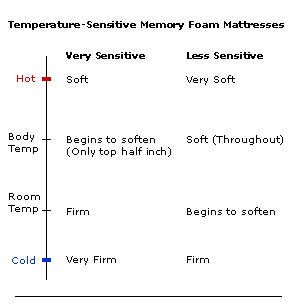Why A Visco Bed May Feel Soft
Some people who try a memory foam bed in a showroom may find it too soft and base their decision to buy or not buy solely on that. There are quite a few factors that can make a visco elastic foam bed appear soft and some of them raise serious questions about its quality. Read what makes the best memory foams first.
Visco elastic foam is generally considered to be too soft to make a bed entirely of it. Even Tempurpedic mattresses are not made entirely of memory foam. Having said that, a visco bed provides good support as long as it's dense enough, is heat responsive and is layered over a firmer core made of good quality high resilience foam.
The core of the visco foam bed is quite stiff to begin with and it takes a few weeks to break in. Some beds in showrooms have been tried out by so many people that it has already been broken in. All memory foam beds soften after the first few weeks but they should not lose support as a result.
Support comes from the high density foam the bed is made of and its firmness ratings. Even if the bed does soften, it will not lose the built-in density that gives it cushion.
When you first lie down on a bed with wide appeal like Tempurpedic, the top layer may feel soft but after a few minutes it reacts and adjusts to your body. The top half inch of good visco foam mattresses softens around your body while the rest remains cool and firm to provide good support.
A visco memory foam bed may feel too soft at higher temperatures. If the environment where you try the bed out feels warm, the entire bed may become softer. That does not necessarily indicate a poor quality bed, but it means you must choose wisely, based on the temperature of your home or the climate where you live in.
Softening of Tempur-Pedic Beds Versus Other Manufacturers

Some viscoelastic foam beds may start softening at normal room temperature which can be a warning sign. Tempur-Pedic beds, for example, soften at near-body temperature and harden when cooler. This makes Tempur beds very temperature-sensitive (heightened sensitivity means they react to a very narrow range of temperatures). So why would other manufacturers make their bedding less temperature-sensitive?
Despite the nicer initial feel, memory foam that gets softer at room temperature may mask a poor quality visco bed. Whereas Tempurpedic beds and other leading brands react only to body temperature and soften only at the top, others are simply softer throughout because all of the visco foam responds to room temperature.
Beware, less temperature-sensitive memory foam beds can become even softer at even higher temperatures which can make the bed too soft to be comfortable.
At body temperature, Tempurpedic beds soften just enough to become comfortable whereas less temperature-sensitive visco foam beds are soft throughout and may lose cushioning. At higher temperatures (hot nights, in warmer climates) the latter are very squishy whereas Tempur beds retain some firmness.
MyFoamMattress.net is an independent buyers guide and is not affiliated with any mattress manufacturer or retailer. Different mattress manufacturers and retailers may advertise on this website but we are not affiliated with them in any way, we do not act as agents on their behalf nor are we their employees.
All care has been taken to provide consumers with unbiased information on memory foam mattresses. This may include both the pros and cons of different products and of different brands. All our content is based on extensive research on existing consumer opinions found online on countless forums, discussion groups and review sites spanning back 6 years. Our findings are meant to act exclusively as a concise summary of all these consumer opinions we have read.
About Us | Contact Us | Resources | Sitemap | Disclaimer | Privacy Policy
This website is Valid XHTML 1.0! | Valid CSS!
Copyright © 2006-2024. All rights reserved.